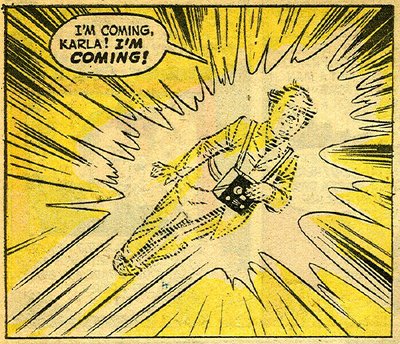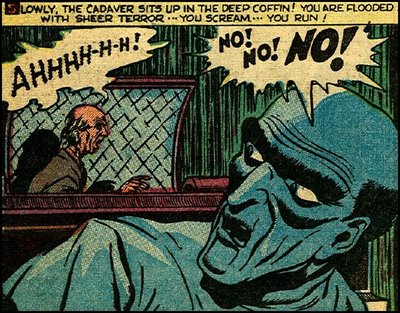Number 9 COVERING IT: Classic Golden Age Comic Book Covers, Part II.These three classic covers of
Tales From The Crypt, all drawn by editor/artist Al Feldstein, form a terrifying triptych of living guys and living dead guys.
These sent shivers through readers encountering these comic books for the first time in the early 1950s. They sent shivers of pleasure through me when I saw them for the first time ten years after their original publication. "These are
neat-o," I thought, in my own unoriginal but expressive adolescent way.

Two of these covers (#22 and #23) are from my collection, and #24 is taken from the Internet. I was impressed by the lead story in #23, written and drawn by Feldstein, called "Reflection of Death." I first saw it in a Ballantine paperback reprint in 1964. The story embodies (get it?
bodies?) those elements which brought EC Comics fame and infamy: graphic images of rotting corpses, lurching around in a grotesque parody of life. Booo-hahaha! I loved it then, I love it now.
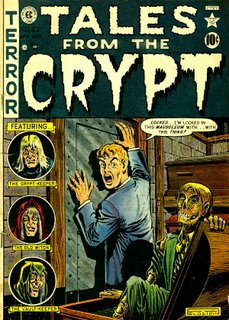
Of the three covers, #24 seems to be the weakest, and not because of the drawing, which is typical Feldstein, straight to the point. Even though his figures were stiff (and his stiffs were figures!) his sense of design and graphic simplicity, with bold inking, made his covers stand out on the crowded newsstands. No, the reason I think it's the weakest is because when examining the cover, even when factoring in the you're-never-gonna-see-this-in-real-life sight of a corpse hauling a guy into a pool of quicksand, the victim isn't fighting back.

I don't know about you, but if some raggedy, stinking, rotting corpse was somehow brought to life and dragging me into a quagmire I'd be fighting back, with whatever means possible! I'd be scratching, kicking, punching and the whole time screaming like a little girl. I sure wouldn't have a neat suit and a tie that's still straight. By the time some zombie got me into the swamp we'd both be the worse for wear. I ain't going down without a fight, not even with a walking dead guy whose muscles have probably decomposed along with most of the rest of him.
Ah, but this is an EC COMIC, you say, and that excuses a lot. In EC Comics the writing was usually good enough, the plots compelling enough, the artwork sensational enough, that the reader would be sucked right into the fantasy. The best horror stories don't have to be probable, just carry their own kind of internal logic. It's kind of a satisfying fantasy, really--vengeance after death, that is--but it's available only in comic book stories like these. So once you get past that you can accept these stories as little cautionary tales, preaching to the readers in their own gruesome way that evil will be answered by evil. An eye-for-an-eye was never truer than in an EC Comic, where justice was done, even from beyond the grave.
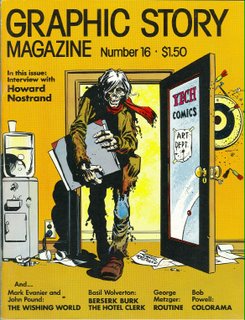






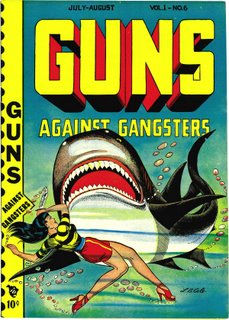


















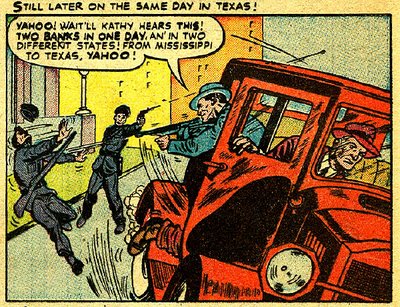
 I don't know who wrote or drew the story. It's a cut above average, even for Crime Does Not Pay. Stories in that magazine were generally well drawn and written (even wordy for comic books). Nobody took credit. You sharp-eyed art spotters out there might be able to identify the artist.
I don't know who wrote or drew the story. It's a cut above average, even for Crime Does Not Pay. Stories in that magazine were generally well drawn and written (even wordy for comic books). Nobody took credit. You sharp-eyed art spotters out there might be able to identify the artist. Kathryn Kelly was to George Kelly what Karl Rove is to George Bush. She deliberately and carefully created his public image. In the Kelly case, Kathryn may be the first PR flack for a notorious criminal.
Kathryn Kelly was to George Kelly what Karl Rove is to George Bush. She deliberately and carefully created his public image. In the Kelly case, Kathryn may be the first PR flack for a notorious criminal.








